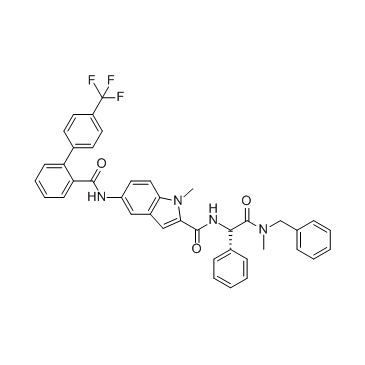86384-98-7
| Name | 3-O-methyl 5-O-[6-[(5-phenyl-1H-pyrazol-3-yl)oxy]hexyl] 2,6-dimethyl-4-(3-nitrophenyl)-1,4-dihydropyridine-3,5-dicarboxylate |
|---|---|
| Synonyms |
3,5-Pyridinedicarboxylic acid,1,4-dihydro-2,6-dimethyl-4-(3-nitrophenyl)-,methyl 6-((5-phenyl-1H-pyrazol-3-yl)oxy)hexyl ester
CV-159 1,4-Dihydro-2,6-dimethyl-4-(3-nitrophenyl)-3,5-pyridinedicarboxylic acid methyl-6-(5-phenyl-3-pyrazolyloxy)hexyl ester CV-159-6 |
| Description | CV-159 is a unique dihydropyridine Ca2+ antagonist with an anti-calmodulin (CaM) action, and has antiinflammatory activities. |
|---|---|
| Related Catalog | |
| In Vitro | CV-159 (0.1-10 μM) significantly inhibits TNF-α (10 ng/ml, 24 h)-induced VCAM-1 in SMCs in a concentrationdependent manner. CV-159 (10 μM, 30 min) significantly inhibits the TNF-induced ROS production[1]. CV-159 (10 μM) inhibits TNF (24 h)-induced expression of e-selectin but not vascular cell adhesion molecule-1 and intercellular adhesion molecule-1. CV-159 inhibits TNF (20 min)-induced phosphorylation of JNK, p38, and NF-κB p65 (Ser536)[2]. |
| In Vivo | CV-159 (5 and 10 mg/kg, p.o.) gives significant protection against delayed neuronal death in the hippocampal CA1 region of the rats after 15-min transient forebrain ischemia. CV-159 also diminishes the size of the brain infarct after permanent middle cerebral artery (MCA) occlusion. CV-159 significantly reduces the increase in the water content of the infarcted cortex induced by MCA occlusion[3]. |
| References |
| Density | 1.249g/cm3 |
|---|---|
| Boiling Point | 755.5ºC at 760 mmHg |
| Molecular Formula | C31H34N4O7 |
| Molecular Weight | 574.62400 |
| Flash Point | 410.7ºC |
| Exact Mass | 574.24300 |
| PSA | 148.36000 |
| LogP | 6.42730 |
| Index of Refraction | 1.586 |
| Storage condition | 2-8℃ |
